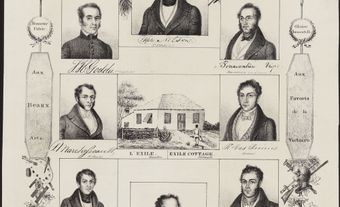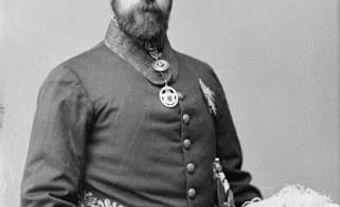This article was originally published in Maclean's Magazine on April 6, 1998
Jonesboro Massacre
The images that a family chooses to keep of its happy moments can be revealing, and the ones saved by the Goldens of Jonesboro, Ark., are no exception. In one, preserved on home video, their son Andrew aims an automatic pistol with studied confidence, grasping it with both hands and squinting down the barrel. In another, he smiles under a big cowboy hat and cradles a BB gun. In a third, he poses in a camouflage outfit with yet another rifle. His grandfather, exaggerating only a little, said last week that young Andrew was introduced to firearms "the day his eyes opened." Andrew Golden, who is still only 11, was clearly comfortable around guns - all too comfortable, as it turned out.
On Tuesday, he skipped his first class and showed up late at Jonesboro's Westside Middle School, where he was in the sixth grade. His friend Mitchell Johnson, 13, told his parents he had a stomachache, and didn't go to school at all. Instead, they gathered an arsenal of weapons - three rifles, seven handguns and hundreds of rounds of ammunition - and took it all to a wooded area some 75 m from the school. According to investigators, Andrew returned to class and, at about 12:30 p.m., asked to be excused to go to the bathroom. He set off a fire alarm, then ran outside to join Mitchell in the woods. As children poured out of the building, shots rang out from the woods again and again - 27 times in all. Within moments, four girls lay dead, one of their teachers was mortally wounded, and 10 other pupils were injured. Jonesboro, the kind of placid southern town where people used to say "It can't happen here," found out in brutal fashion that, yes, it can - and yes, it does.
By week's end, Andrew Golden and Mitchell Johnson were being held in a juvenile detention centre, charged with five counts of capital murder and 10 of assault. Andrew, a skinny kid with a buzz cut who looks even younger than his 11 years, was crying and, a sheriff said, "wants his mama." Mitchell, a chubby boy whom classmates said used to claim membership in the Bloods, a nationwide gang, was reading a Bible. His father, Scott, said his son was "remorseful," but had no explanation for what the boy was accused of doing. That, of course, did not stop the experts. The tragedy in Jonesboro was the third recent incident involving multiple shooting deaths at southern schools - and it immediately became a battlefield for warring explanations of why children so young can go so wrong. They are the products, said some, of a society that has lost its moral moorings and is saturated with images of violence. "It should shock us and wake us up," said Arkansas Gov. Mike Huckabee. "It's a cultural disease."
Others pointed to the guns that loomed so large in the Golden family's treasured memories. Arkansas has some of the most lax gun laws in the United States. It is illegal for anyone under 21 there to own a handgun, but there are no restrictions on who can possess a rifle or shotgun. Schools around Jonesboro, a city of 50,000 set amid the flat farmland of northeastern Arkansas, close for as long as a week each autumn for deer-hunting season. Andrew Golden's experience with guns was typical of boys growing up there, and in much of the South. He was given his first rifle when he was 6. He shot his first duck last year, when he was 10, and planned to try for his first deer in the fall.
And even in the wake of last week's killings, there was no serious call in Arkansas for a crackdown on firearms. Hunting in the South, people were quick to point out, is a valued bonding experience shared by all. A 13-year-old girl, Cassie Morris, sitting quietly at a roller rink in Jonesboro, jumped into a conversation about the size of bullets used in the shootings, rolling off gun terms with ease. She already goes to a gun club with her father, and now, she says, "I want a gun, and I'm going to get one in a couple of months." The state police spokesman in Jonesboro, Bill Sadler, added that "people enjoy their hunting privileges, and they don't want something like this to ruin those privileges." Those attitudes go to the highest levels of state government: Huckabee is a fierce opponent of gun control, and last year even vetoed background checks for people seeking to buy handguns.
There was, at least, no mystery about how the boys obtained their arsenal. According to authorities, they first went on Tuesday morning to Johnson's home and tried to break into a steel safe where his father, Dennis, kept his weapons. They failed, but stole several handguns that were not locked up. Then, they went to the home of Andrew's grandfather, Douglas Golden, a gun collector and hunter. They broke in through a basement window and stole three rifles, more handguns and 3,000 rounds of ammunition. Doug Golden, a state wildlife officer, said later that Andrew admitted to him that they used his guns. "I don't know what in God's name they could have been thinking," he said.
The boys then allegedly loaded the weapons into a grey van and parked on a road near the school. Mitchell lay in wait in the woods, while Andrew went inside. When police responded to a 911 emergency call at 12:40 p.m., they spotted the boys emerging from the woods and running towards the van. Mitchell, police said, was carrying a 30-06 hunting rifle; Andrew had a .30-calibre carbine. Officers who searched the van found a stock of food, sleeping bags, a crossbow, hunting knives and wilderness survival gear. The boys, it appeared, had planned to run away.
In fact, Mitchell Johnson had told classmates as much the day before. No one took him seriously, they said later, but the warnings were specific and horrifying. Mitchell, they said, was upset that a girl in the sixth grade, Candace Porter, had broken up with him. On Monday, he threatened other students at school. "He told us that tomorrow you will find out if you live or die," seventh-grader Melinda Henson told a local newspaper. Charles Vanoven, another seventh-grader, said: "He told me that all the people who broke up with him, you know, he's going to come to school tomorrow and shoot them. I thought he was just kidding around." Mitchell also singled out Shannon Wright, the 32-year-old teacher who died last week sheltering pupils from gunfire. "He said he hated Mrs. Wright and some day he was going to kill her," said Micah Angel, 10, who rode the school bus with Mitchell. In fact, Candace Porter was among those wounded in the fusillade. Natalie Brooks, Paige Ann Herring and Stephanie Johnson, all 12, died along with 11-year-old Brittany Varner.
It was the third deadly incident involving students and guns in five months in the South. On Dec. 1, a 14-year-old boy shot three students to death and wounded five others while they attended a prayer meeting at his high school in West Paducah, Ky. And on Oct. 1, a 16-year-old boy murdered his mother with a knife, then shot two students to death and wounded seven others at his school in Pearl, Miss. Three incidents is enough for the media to declare a trend, but in fact there is nothing to connect them. In West Paducah, the killer was reportedly inspired by a dream sequence in the 1995 movie Basketball Diaries, in which a character played by Leonardo DiCaprio walks into a classroom and shoots several students with a shotgun. In Pearl, the killer was apparently part of a Satanic cult called "the Group."
Nor is there any general trend towards more violence among young people in the United States. On the contrary, a study released last week by the Justice Policy Institute, a Washington think-tank, shows that homicide arrests among juveniles dropped by 30 per cent between 1994 and 1996. The reason, said researcher Jason Ziedenberg, is the general drop in crime across the United States coupled with tighter federal regulations on handguns adopted in 1995. "There is no trend," said Ziedenberg. "There's a panic, but it's a false panic." The disconnect between reality and perception, he suggested, may be partly explained by another study. The Center for Media and Public Affairs, also in Washington, found that coverage of murder on the nightly newscasts of the three major American networks is up fully 700 per cent since 1993.
There may be little prospect for stricter gun control in Arkansas, but the killings did prompt moves towards tougher treatment of juvenile offenders. Since both accused killers in Jonesboro are under 14, they can be detained only until age 18 under Arkansas law, even if they are judged responsible for the murders. A federal bill that would encourage states to try violent younger offenders in adult courts has been stalled in Congress, but the spate of high-profile school killings gave it new life. The irony is that such measures would do nothing to stop children like Mitchell Johnson and Andrew Golden from getting hold of guns and using them - but only make it easier to lock them up for long periods after they have inflicted their pain.
Maclean's April 6, 1998

 Share on Facebook
Share on Facebook Share on X
Share on X Share by Email
Share by Email Share on Google Classroom
Share on Google Classroom


